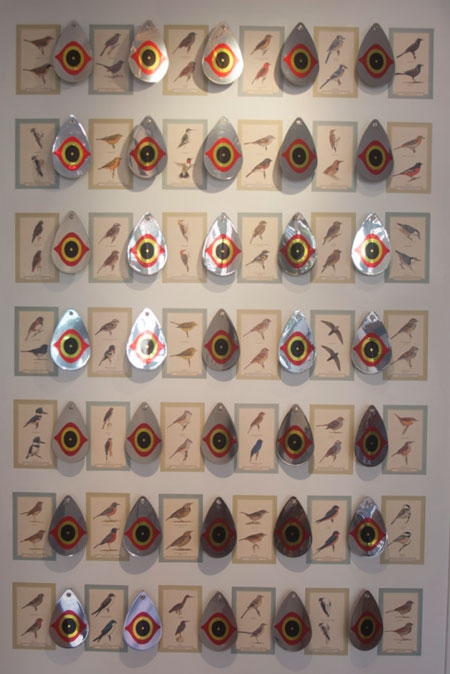 Environmental artist Lynne Parks has an interesting exhibition, “Flight Risk,” showing at the Sandbox Initiative on Cross Street until Septemeber 17. Parks has merged her love for all things avian with a surprising way to safeguard bird flight—you know, those lethal glass windows—presented as a display of reflective tear-dropped shields with insignias signifying predators to scare the birds away. These are placed among rows of Audobon-like bird illustrations to help convey the reality that these collisions can be prevented. It’s a little Joseph Cornell, and a lot ingenious and should be seen with the rest of her presentation.
Environmental artist Lynne Parks has an interesting exhibition, “Flight Risk,” showing at the Sandbox Initiative on Cross Street until Septemeber 17. Parks has merged her love for all things avian with a surprising way to safeguard bird flight—you know, those lethal glass windows—presented as a display of reflective tear-dropped shields with insignias signifying predators to scare the birds away. These are placed among rows of Audobon-like bird illustrations to help convey the reality that these collisions can be prevented. It’s a little Joseph Cornell, and a lot ingenious and should be seen with the rest of her presentation.
A reception to meet the artist will take place September 4, from 5-7 pm at Sandbox.
Parks will also give an illustrated talk at 5 pm September 16 at Litrenta Lecture Hall, Toll Science Center, Washington College.
Parks writes about her work:
“I’ve always loved birds. I come from a family of bird lovers. My dad was one of those magical people who could feed yard birds out of his hand and he was always helping injured animals. I feel like I’m continuing his work. Every year we learn more about the incredible intelligence of modern dinosaurs, birds. Too many are dying from manmade structures placed along their migratory pathways. A fatal combination of light pollution and glass kills as many as a billion birds in the United States each year and many populations are in decline. I hope to encourage developers and architects to build in accordance with nature’s great movements or we’ll lose the many benefits birds provide. From ecoservices to aesthetics, birds have always been with humans. In my multimedia work, I address the marvels of avian physiognomy and the dangers mankind has inadvertently created for wildlife in the brief modern era. Our ingenuity has outpaced many birds ability to adapt. Let’s use that ingenuity to save them,” write Lynn Parks;
For centuries the beauty of the natural world has been celebrated through creative practices. Art has long documented and inspired the wonders of nature. From cave paintings etched onto rock that date back as far as 40,000 BCE depicting images of animals and man sharing the land, to Frida Kahlo’s numerous self-portraits of her among plants and animals – there is no doubt that man longs for a connection to the natural world. In this, art and nature have a symbolic relationship, an interplay: nature intrigues man with its elusive complexities and man honors her in creative homage.
In Flight Risk Lynne Parks displays her passion for and dedication to the aviary world. Through her meticulous, mindful craft, the incredible beauty of these animals is revealed, yet upon closer inspection there lies a narrative. The organic color and line of the birds’ feathers is among lines of light formed by manufactured glass. The birds are still, lifeless. Parks confronts us with documentation of the damage our constructed lives unintentionally leave in their wake. Our mark – our footprint – is now visible.
The beauty of these images is alluring. It entices us to study these incredible creatures – in their stillness we are able to soak in details, understand their nuances, and explore their delicate, fragile beauty. Each strikes a distinct pose like a character in a play. Each is different, elegant and stunning.
Bird songs play overhead, immersing the viewer in the auditory gifts these creatures provide. Yet the songs are the silenced voices of the 98 species of birds found dead in Baltimore over a five period. Their ghostly songs haunt the exhibition space. Silence periodically punctures the soundtrack, serving as a warning of what is to come if we fail to consider these creatures in our future constructions.
There are solutions.
Following a purposeful design, we find such an example placed upon the gallery window. To reduce bird to glass impacts, Parks cuts CollidEscape film into shapes of bird species – drawn from her photographs – found in the Mid-Atlantic region particular to Baltimore and Chestertown.
Through her careful, minimal compositions Parks celebrates the complex beauty of these animals. Her homage has a message, examples of what is, and foreshadowing what is to come if we continue our careless ways.



Write a Letter to the Editor on this Article
We encourage readers to offer their point of view on this article by submitting the following form. Editing is sometimes necessary and is done at the discretion of the editorial staff.